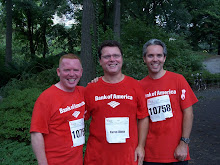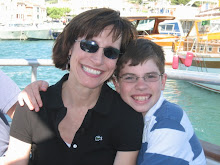
Karen's planned chemotherapy regimen may best be described as "shock and awe." I'm not sure any chemo protocol is light fare, but the treatment course prescribed as part of the clinical trial she'll participate in shortly is designed to pound the hell out of any cancer that may be left in Karen's body.
Today we got a chemotherapy tutorial -- a 2+ hour introduction to all-things-chemo. We left more educated and anxious to get this phase of treatment underway. We also left with a sense of dread (or I did) now that we are weeks away from Day 1 of a 22 week -- yes, 22 weeks -- course of treatment. That's 154 days, but who's counting?
The chemotherapy protocol involves three standard chemo drugs (Adriamycin, Cytoxan and Taxol, referred to as AC/T) and a fourth drug (Bevacizumab, aka Avastin) introduced as part of the clinical trial. The purpose of the clinical study is to determine if adding Avastin to standard chemotherapy reduces the risk of the cancer coming back, compared to using standard chemotherapy alone. The study specifically targets patients "who have breast cancer that has been surgically removed but has features that have a significant risk of recurrence". Karen fits this profile because she has "triple negative cancer" which is more aggressive and has a higher rate of recurrence.
The chemo protocol is what they call "dose dense" -- the intervals between each chemo treatment are shorter than with a standard protocol. So, instead of three weeks between each treatment, Karen will get chemo infusions every
two weeks. Since the treatments are closer together, the theory is that the cancer has less of a chance to grow. But the higher frequency in treatments make these protocols tougher to endure. (Fortunately, Karen received an "I AM STRONG" T-shirt and bracelet from the American Cancer Society courtesy of a thoughtful client, so I think she's ready to go!).
In an earlier posting I shared some of the common, possible and rare side effects from the drugs. They're all ugly, so I won't bother re-hashing them again. Before we left our appointment today, we were armed with at least 5 or 6 anti-nausea prescriptions. I think you get the point. We also got other tips and instructions on what to look for and what to do when any of the other nasty or serious side effects occur.
In short, the 22 weeks of treatment break down like this:
- AC plus Avastin (or a placebo) every 2 weeks for 8 weeks. First treatment: 7/9
- 2 week break
- Taxol (T) plus Avastin every week for 12 weeks.
And on the 7th day, we rest.
The toughest part of the treatment will be the AC -- the first 8 weeks -- in part because the drugs have a cumulative effect. Our goal: make it to Labor Day! Depending on which "arm" of the trial she is on, she may continue the Avastin drug for another 10 weeks after the Taxol. There's a 20% chance she will receive the placebo instead of Avastin (she won't know that until near the end of the trial).
So...this is probably way more than you wanted to know (not that you asked). Chemo is fascinating, isn't it? If you logged on for more stories about Karen's attempt to squeeze into a new pair a jeans (see
"Do I look fat in these jeans?" below), I'm sorry to disappoint you. But since this "journey" would not be nearly as fun without showcasing more of "My Life with Karen" (as opposed to "My Wife with Cancer"), please be sure to return on a day when we're not consumed with this annoyance called cancer.
 Karen and her friend, Sandy, picked up Karen's new wig on Saturday and it looks great! Truth is, you probably wouldn't know it's a wig unless you were really looking carefully, and even then I'm not sure.
Karen and her friend, Sandy, picked up Karen's new wig on Saturday and it looks great! Truth is, you probably wouldn't know it's a wig unless you were really looking carefully, and even then I'm not sure. 










